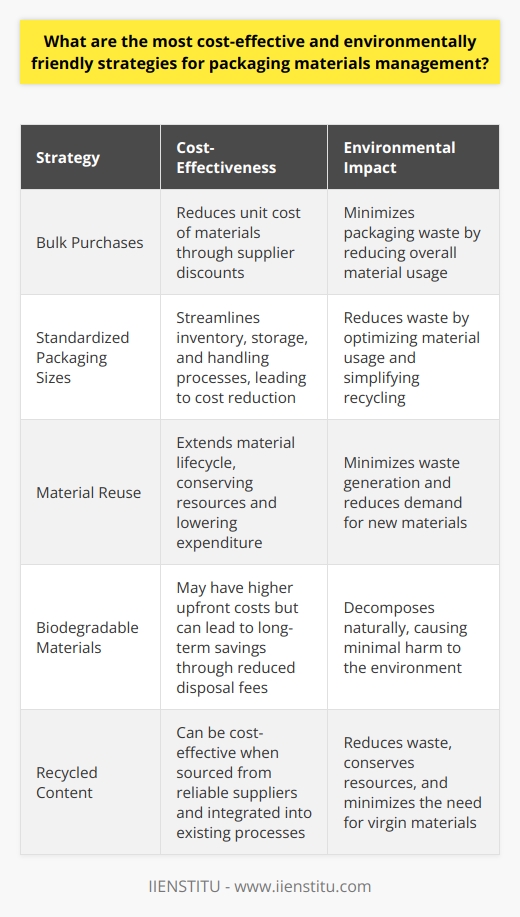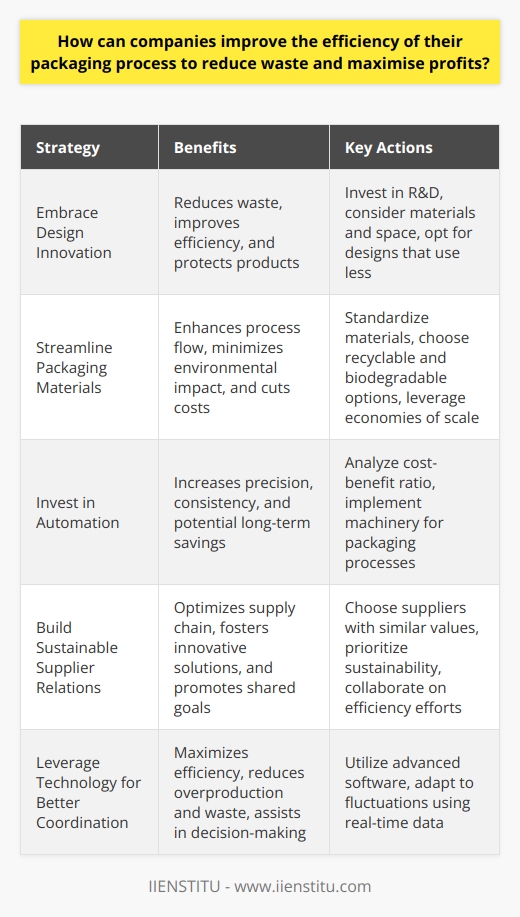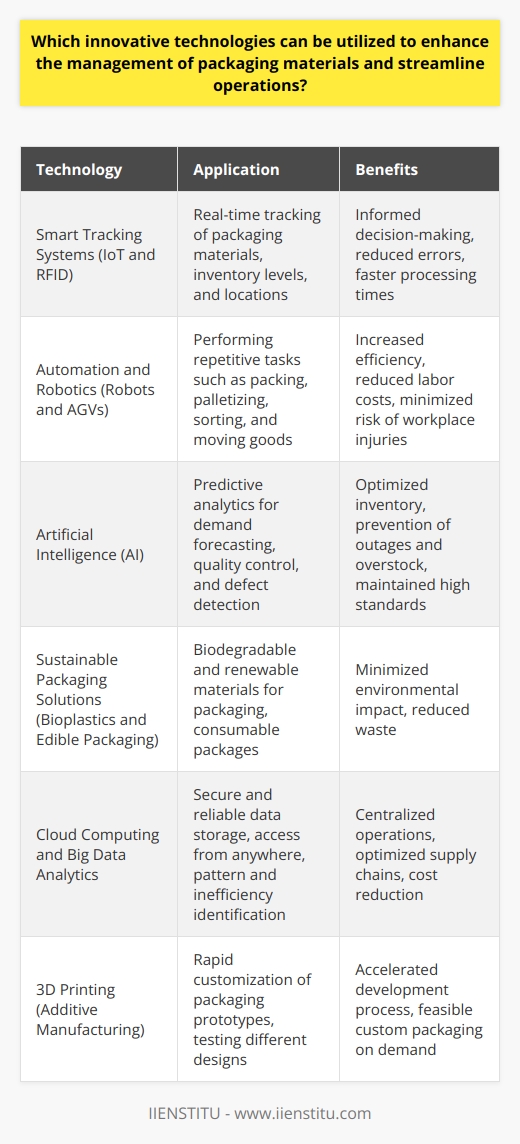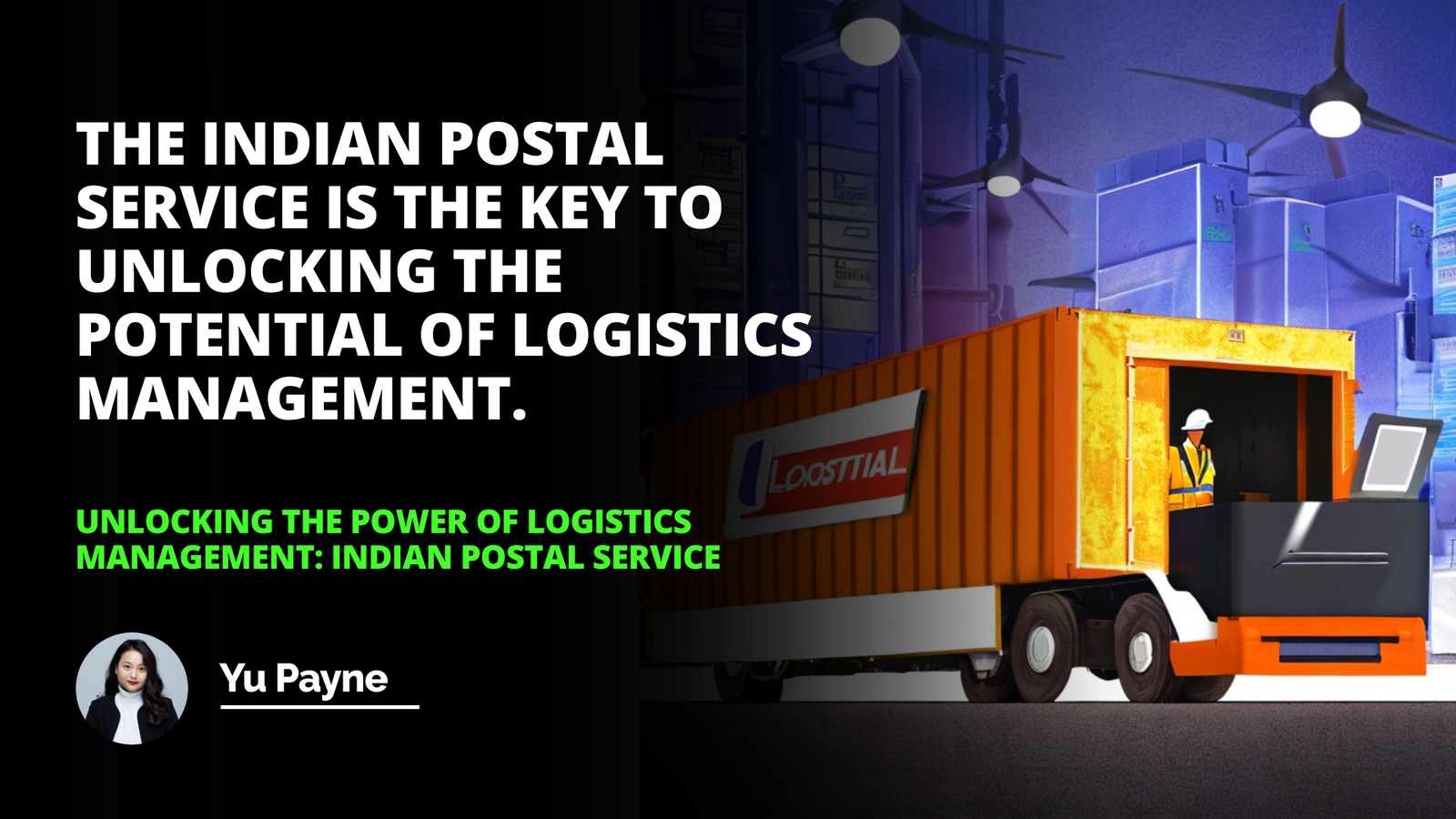
In the intricate domain of product manufacturing and distribution, the management of packaging materials is a fundamental aspect that significantly affects the operational efficiency, cost-effectiveness, and environmental footprint of a company.
Given its centrality to the logistical operation of industries, an expert understanding and strategic approach to packaging materials management has become more important than ever. This blog delves into the nuances of managing these materials and presents the reader with strategies honed by the industry's vanguard, aiming to provide comprehensive insights that can be applied to businesses of all scales.
We will unravel the complexity of packaging materials, unpack the challenges inherent in managing them, and offer practical solutions, elucidated through real-world case studies, all while demonstrating the pertinence of a logistics course or online certification courses in elevating one’s expertise in this field.
Understanding Packaging Materials
Definition and Types of Packaging Materials
At its core, packaging materials are the collective assortment of items and substances used to protect products, facilitate transportation, and communicate information to consumers. From the ubiquitous corrugated boxes to the innovative biodegradable films, the range of materials utilized is extensive, each with its specifications and applications.
The common materials such as cardboard, plastic wrap, glass, and metal are omnipresent in the consumer market, providing a baseline for industry standards. However, new materials are continually introduced, each with a unique set of properties designed to suit specific product needs, such as high durability for electronics or enhanced preservation qualities for perishables.
Importance of Choosing the Right Packaging Materials
Amidst global competition and heightened consumer expectations, the choice of packaging materials is no small decision. It encompasses concerns of cost, durability, and appearance, all of which must be balanced to assure product quality and brand perception.
Selecting the right materials is vital in safeguarding products against damage during transit, thereby reducing the likelihood of returns and preserving customer satisfaction. Additionally, this choice is a primary contributor to a brand’s image, communicating values such as luxury or eco-friendliness through the selected packaging aesthetics and functionalities.
Brand Image Representation
Beyond protection and preservation lies the power of packaging in brand storytelling. Thoughtfully chosen materials can embody a brand's ethics, whether it's the rustic simplicity of recycled cardboard for an organic product range or the sleek transparency of high-density polyethylene for cutting-edge gadgets. A well-crafted package is a silent ambassador for the brand, its design and construction reinforcing consumer trust and enhancing the unboxing experience, which has become an influential aspect of modern consumerism.
Challenges in Packaging Materials Management
Cost-Related Issues
Managing packaging materials poses significant cost-related challenges. Procurement teams are tasked with sourcing high-quality materials that meet budgetary constraints and production schedules. The purchasing of these materials can entail complex negotiations with suppliers, long-term contracts, and the need for bulk storage, all of which require careful financial planning. Moreover, opting for premium quality materials often incurs higher costs, impacting the overall cost structure of the product and potentially its market price.
Sustainability Issues
Alongside financial considerations, the pressing issue of environmental sustainability dominates the discourse on packaging materials. Traditional packaging solutions, especially certain plastics, are under intense scrutiny due to their ecological impact. It is incumbent upon businesses to address this by seeking out eco-friendly options, which often come with their own challenges, such as availability, cost, and compatibility with existing manufacturing processes.
Demand for Eco-Friendly Packaging Materials
Consumer and legislative pressures are driving the demand for eco-friendly packaging materials. Companies are increasingly expected to demonstrate environmental responsibility by incorporating recyclable, compostable, or biodegradable materials into their packaging solutions. Balancing this with requisite durability and aesthetic appeal necessitates tireless research and development efforts as well as strategic adjustments in procurement practices.
Strategies for Effective Packaging Materials Management
Procurement Strategies
Procurement is often a key area where packaging materials management can be optimized. Bulk purchasing is a common strategy for cost reduction, securing lower prices per unit and reducing the frequency of order placements. However, this must be matched with a keen sense of forecasting to avoid overstocking or obsolescence. Additionally, meticulous material selection and testing are imperative to ensure that the desired balance of quality and cost is achieved, thereby avoiding the pitfalls of substandard materials which can lead to product damage or customer dissatisfaction.
Sustainable Materials Management
When it comes to sustainability, transitioning to eco-friendly packaging requires a holistic approach. It is not only about selecting recycled or biodegradable materials but also about refining the packaging design to minimize waste. This might involve reducing the overall use of materials, simplifying packaging to improve recyclability, or implementing a return system for reusable packaging. Integrated waste management strategies that include recycling and waste-to-energy processes are equally important in reducing the overall environmental impact.
Technological Advancements in Material Management
Embracing digital transformation can markedly enhance material management efficiency. Digital tools help in tracking and analyzing material usage, providing valuable data for forecasting and inventory control. Automation, from precise cutting machines to robotic packing lines, has revolutionized material processing, ensuring consistent quality and allowing for more complex packaging designs that are still produced with efficiency.
Related source:
Case Studies on Successful Packaging Materials Management
Companies that Excel in Packaging Materials Management
Some companies are leaders in the field of packaging materials management, setting benchmarks with their innovative and efficient methods. By studying these enterprises, we can discern the practical applications of the strategies discussed. These companies often integrate material sourcing with design and processing, fostering a seamless symbiosis that optimizes both the protective and promotional functions of packaging.
Lessons to Learn from These Case Studies
Case studies provide tangible evidence of successful practices, offering models that can be adapted to various business contexts. From small-scale optimizations like localized sourcing to larger systemic changes such as adopting cradle-to-cradle design principles, these examples serve as a repository of lessons that other businesses can emulate. One key takeaway is the importance of continuous innovation and adaptability, ensuring that packaging materials management processes remain aligned with evolving market demands and regulatory landscapes.
Recap of Key Points in the Blog
As this discussion concludes, it is essential to recapitulate the significance of effective packaging materials management, from the implications of selection to the necessity of addressing cost and sustainability issues. The entrails of materials procurement, sustainable practices, and technological interventions hold the blueprint for efficacious management strategies.
Encouraging Further Exploration and Learning in the Field of Packaging Materials Management
For those aiming to specialize in this domain, pursuing a logistics course or various online certification courses can provide valuable insights and skills. Continuous learning is imperative in a field that is perpetually evolving with new materials, regulations, and consumer expectations.
The realm of packaging materials management is a dynamic one, contoured by innovations and heightened environmental considerations. As companies steer towards a more sustainable and cost-effective future, the packaging will undoubtedly continue to play a pivotal role in translating business strategies into consumer experiences.
The companies that succeed will be those that exercise discernment, ingenuity, and adaptability in managing their packaging materials, reaffirming their commitment to quality, efficiency, and environmental stewardship.
Frequently Asked Questions
What are the most cost-effective and environmentally friendly strategies for packaging materials management?
Cost-Effectiveness in Packaging
Cost determines material management choices. Businesses seek economic sustainability. They aim for low-cost, high-efficiency packaging. Multiple strategies achieve this balance.
Bulk Purchases Reduce Costs
Buying in bulk saves funds. Suppliers offer discounts for large quantities. This reduces unit cost of materials significantly.
Standardize Packaging Sizes
Uniform packaging sizes streamline processes. They simplify inventory, storage, and handling. Consistency leads to cost reduction over time.
Reuse Materials When Possible
Reuse extends material lifecycle. It conserves resources and lowers expenditure. Durable and flexible materials facilitate this practice.
Environmental Factors in Packaging
Environmental sustainability guides packaging choices. Companies focus on reducing ecological impacts. They introduce greener practices in material management.
Prefer Biodegradable Materials
Biodegradable materials offer environmental benefits. They decompose naturally, causing minimal harm. Examples include paper, cardboard, and certain plastics.
Recycled Content Uptake
Recycled materials lessen ecological burden. They reduce waste and conserve resources. Incorporating these into packaging prioritizes sustainability.
Minimize Material Use
Less is often more. Reducing packaging material curtails waste. This helps maintain an eco-friendly brand image.
Combined Strategies for Optimal Results
Combining cost-effective with eco-friendly strategies is key. Managers must assess their integrated impact.
Opt for Multi-Use Packaging Designs
Designs promoting reuse serve dual aims. They reduce costs and waste. Customers appreciate such practical sustainability.
Innovate with Edible Packaging
Edible packaging is emerging. It presents no waste issues. It is an intriguing avenue for R&D departments.
Integrate Lifecycle Analysis
Lifecycle analysis reveals true costs. It considers production to disposal stages. This ensures environmentally-informed economic decisions.
Effective packaging material management mandates a delicate balance. It looks for economic and ecological efficiency. Businesses need innovative, strategic thinking to achieve this.

How can companies improve the efficiency of their packaging process to reduce waste and maximise profits?
Efficient Packaging Process: The Key to Less Waste and More Profit
Assess Current Practices
Businesses must first understand their existing processes. This step involves a thorough analysis. Managers should identify and document every step. Waste often stems from outdated methods. Companies can then pinpoint inefficiencies.
Embrace Design Innovation
Smart design can significantly reduce waste. Companies should invest in research and development. Custom packaging solutions are often more efficient. They should consider materials and space. Opt for designs that use less. Yet, ensure they protect products well.
Streamline Packaging Materials
Variety in materials can lead to inefficiency. Standardize materials for better process flow. Choose recyclable and biodegradable options. These choices will minimize environmental impact. They can also cut costs long-term. Companies benefit from economies of scale.
Invest in Automation
Automation technology aids in efficiency. Machinery is precise and consistent. Humans can make errors and may be slower. Analyze the cost-benefit ratio of automation investments. Over time, these can lead to savings.
Train Employees
Well-trained staff can make a difference. Training should be continuous and multifaceted. Staff learn best practices and new techniques. Encourage a culture of efficiency and sustainability. Each employee contributes to the company's eco-footprint.
Monitor, Measure, and Improve
Continuous improvement is vital. Regular monitoring and measuring ensure standards. Use key performance indicators to track progress. Adjust strategies based on reliable data. Improvement is an ongoing process.
Build Sustainable Supplier Relations
Suppliers are partners in efficiency. Choose suppliers with similar values. They should prioritize sustainability. Collaborative efforts can optimize the supply chain. Shared goals can foster innovative solutions.
Reduce Shipping Volume
Excess shipping space is wasteful. Companies should optimize box sizes. Automated packing machines often help. They adjust packaging to fit the product. Fewer materials and reduced shipping costs result.
Encourage Customer Recycling
Education extends beyond the company. Inform customers about recycling. Packaging should have clear recycling instructions. Incentives for customers can promote recycling. This step extends the life cycle of materials.
Leverage Technology for Better Coordination
Advanced software can coordinate operations. Real-time data assists in decision-making. It helps companies adapt to fluctuations. This coordination maximizes efficiency. It also reduces overproduction and waste.
Efficiency in packaging processes saves money. It protects the environment. Through these steps, companies can thrive. Sustainable practices are not just ethical. They make good business sense in a resource-conscious market.

Which innovative technologies can be utilized to enhance the management of packaging materials and streamline operations?
Streamlining Packaging Management with Tech Advances
Smart Tracking Systems
The rise of the Internet of Things (IoT) allows for real-time tracking of packaging materials. Sensors affixed to packages gather data. This data informs inventory levels and locations. Managers can thus make informed decisions.
Radio-frequency identification (RFID) ensures better tracking capabilities. Each package or pallet carries an RFID tag. These tags store and transmit data. Scanners read and update the information. Such a system reduces errors. It speeds up processing times too.
Automation and Robotics
Robots have transformed packaging management. They perform repetitive tasks reliably. They excel in packing, palletizing, and sorting. Efficiency in these areas soars. Robots reduce labor costs. They also minimize the risk of workplace injuries.
Automatic Guided Vehicles (AGVs) move goods in warehouses. They use lasers or magnets for navigation. AGVs streamline the internal flow of materials. They increase efficiency. They eliminate manual handling almost entirely.
Artificial Intelligence
Artificial Intelligence (AI) drives predictive analytics. AI models forecast demand for packaging materials. They analyze historical data and current trends. This provides actionable insights. Managers can optimize inventory. They prevent outages. They reduce overstock too.
AI enhances quality control during the packaging process. Cameras and algorithms detect defects. They monitor packaging integrity. Faulty or damaged items face rejection. This maintains high standards.
Sustainable Packaging Solutions
Sustainability drives innovation. Bioplastics offer an alternative to traditional plastics. These biodegradable materials come from renewable sources. They minimize environmental impact.
Edible packaging takes innovation further. Made from natural substances, these packages can be consumed. They produce no waste. This offers a new level of environmental consideration.
Cloud Computing and Big Data
Cloud computing facilitates data storage and access. Packaging operations produce vast amounts of data. The cloud houses this data securely and reliably. Stakeholders access information from anywhere. This centralizes operations.
Big data analytics can optimize packaging supply chains. They identify patterns and inefficiencies. Managers leverage these insights. They enhance just-in-time inventory practices. They cut costs as well.
3D Printing
3D printing, or additive manufacturing, customizes packaging prototypes rapidly. This accelerates the development process. Ideas turn into tangible products quickly. This technology tests different designs without extensive costs. Custom packaging on demand becomes feasible.
Innovative technologies elevate packaging management. Each technology targets specific challenges. Together, they offer a holistic solution. They streamline operations significantly. Adopting these technologies positions companies ahead. It offers a critical edge in a competitive market.



